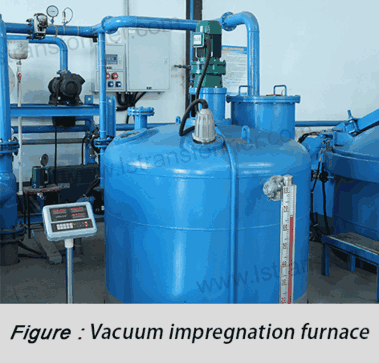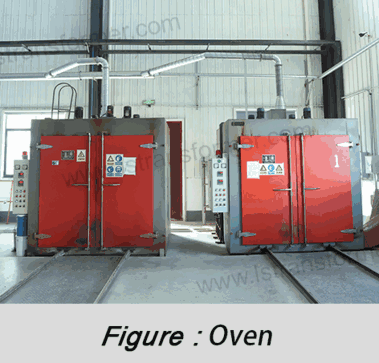What is the Role of Vacuum Pressure Impregnation (VPI) Process? — The Key Step to Enhance Insulation Life in Dry-Type Transformers
What is the Role of Vacuum Pressure Impregnation (VPI) Process?
— The Key Step to Enhance Insulation Life in Dry-Type Transformers
In data centers, commercial buildings, renewable energy power stations, and industrial facilities worldwide, low-voltage dry-type transformers have become critical components of power distribution systems due to their core advantages: oil-free operation, fire resistance, environmental friendliness, and ease of maintenance. However, their long-term reliability and insulation lifespan are fundamentally ensured by a crucial manufacturing process—Vacuum Pressure Impregnation (VPI). Far from being a simple impregn)**. Far from being a simple impregnation step, VPI is a precise physical process designed to eliminate microscopic defects within windings, creating a dense, uniform, and defect-free integrated insulation system. This significantly enhances the electrical performance, environmental resistance, thermal management efficiency, and mechanical strength of low-voltage dry-type transformers, making it the key to achieving a 30-year or longer service life.
Content
1. Electrical Performance Leap: Eliminating Partial Discharge and Doubling Dielectric Strength
●Root Cause (Problem):
The winding structure of low-voltage dry-type transformers is complex, with numerous microscopic air gaps and capillary pores between conductors, interlayer insulation materials (e.g., Nomex® paper, fiberglass cloth), and supports. These pores easily trap trace moisture or air during manufacturing and operation. The dielectric strength of air and water (~3 kV/mm) is far lower than that of epoxy resin (>20 kV/mm). Under high-voltage electric fields, the gas/liquid molecules in these pores ionize, triggering partial discharge (PD). Continuous partial discharge acts like "tiny electrical sparks," relentlessly eroding the insulation material, breaking polymer chains, and causing gradual carbonization. This leads to ongoing insulation degradation and eventual breakdown.
● VPI Solution (Measures):
(1)Deep Vacuum Stage: The assembled transformer windings are placed in a vacuum chamber and evacuated to high vacuum (typically <1 mbar). The vacuum serves two critical purposes:
-Forcefully removesair and adsorbed moisture from pores, drastically reducing internal gas density and humidity, thereby eliminating the root cause of partial discharge.
-Opens and clearscapillary channels within the insulation material, preparing them for resin penetration.
(2)Pressure Impregnation Stage:While maintaining vacuum or low pressure, low-viscosity, solvent-free epoxy resin is injected to fully submerge the windings. High pressure (typically 5-8 bar) is then applied. This pressure drives the resin rapidly and deeply into all micro-pores, capillaries, and minute gaps between winding layers and turns, replacing and filling any residual gas.
●Performance Improvement (Result):
(1)Significantly higher dielectric strength:The dense resin nearly eliminates all low-strength air gaps, dramatically increasing the breakdown voltage of the insulation system. This follows the dielectric strength formula:
Eb∝(d⋅εr)−1
where Eb is the breakdown field strength (kV/mm),d is the effective air gap size (mm), and εr is the material's dielectric constant. VPI minimizes d, thereby boosting Eb.
(2)Ultra-low partial discharge:Compliant with IEC 60076-11 standards for dry-type transformers, VPI ensures the partial discharge inception voltage (PDIV) far exceeds the operating voltage. Measured partial discharge (PD) levels are consistently stabilized at <5 pC (well below the standard limit of ≤10 pC), guaranteeing long-term discharge-free operation and extended lifespan.
(3)Stable capacitance characteristics:The homogeneous insulation structure delivers more stable and predictable capacitance parameters, aiding system protection and condition monitoring.
2. Environmental Protection: Building a Shield Against Moisture, Contamination, and Chemical Erosion
● Root Cause (Problem):
Low-voltage dry-type transformers are often deployed in harsh environments—high humidity (coastal, tropical), dusty (industrial zones), or corrosive gas (chemical plants, wastewater treatment) conditions. Non-VPI-treated windings (e.g., dip-coated) may have surface protection, but internal micro-channels and interlayer gaps remain unsealed. This allows moisture, salt spray, conductive dust, and acid/alkali vapors to slowly infiltrate the insulation or accumulate in unfilled gaps. Consequences include reduced insulation resistance, increased leakage current, electrochemical corrosion, surface tracking, and even flashover failures, accelerating insulation aging.
● VPI Solution (Measures):
During high-pressure impregnation, epoxy resin not only fills internal pores but also forms a continuous, dense, seamless encapsulating layer over the entire winding (conductors, insulation, supports).This layer:
(1)Physically blocks all contact channels between the winding and external environments.
(2)Epoxy resin itself offers excellent hydrophobicity, chemical resistance, and mechanical strength.
● Performance Improvement (Result):
(1)Superior moisture resistance:The winding achieves high-level sealing (e.g., IP23 protection). Even after damp heat tests (IEC 60068-2-78), insulation resistance (IR) and polarization index (PI) remain high (PI often >3.0, far exceeding the standard ≥2.0), outperforming non-VPI products.
(2)Strong contamination resistance:The cured resin's smooth, dense surface minimizes pollutant buildup, improving surface flashover voltage.
(3)Excellent chemical resistance:Effectively withstands corrosion from industrial gases and liquids.
(4)Enhanced mechanical strength:The cured resin bonds all components into a solid unit, significantly improving resistance to short-circuit electromagnetic forces (meeting IEC 60076-5 requirements).
3. Thermal Management Optimization: Eliminating Hotspots and Extending Thermal Life
● Root Cause (Problem):
During operation, windings generate heat due to conductor resistance (copper loss). Heat must transfer through insulation to the core and cooling surfaces. However, air gaps act as thermal insulators (thermal conductivity of air ≈0.026 W/mK), creating high thermal resistance barriers that impede heat flow. This causes heat accumulation at gaps, forming local hotspots far hotter than the average winding temperature. Per the Arrhenius Law, the thermal aging rate of insulation materials grows exponentially with temperature:
L∝e−Ea/(k⋅T)
where:
L= insulation lifespan,
Ea= material activation energy,
k= Boltzmann constant,
T= hotspot temperature (Kelvin).
For Class H insulation (design hotspot: 155°C), a 10°C rise in hotspot temperature halves the theoretical thermal life! Chronic overheating accelerates polymer degradation, internal chemical reactions, and may lead to carbonization or melting, causing interturn or interlayer shorts.
● VPI Solution (Measures):
VPI fills gaps with epoxy resin, which:
(1)Eliminates air gap thermal barriers:Replaces air with resin (thermal conductivity ≈0.2-0.3 W/mK, 10× better than air), reducing contact thermal resistance.
(2)Creates efficient heat paths:Resin forms continuous thermal bridges between conductors and insulation (e.g., Nomex®), enabling uniform and efficient heat transfer to the core and cooling surfaces.
● Performance Improvement (Result):
(1)Hotspot temperature reduction:VPI lowers critical hotspot temperatures by 10-15°C versus conventional methods. For Class H insulation, reducing hotspots from 130°C to 115°C or lower multiplies thermal life per Arrhenius Law.
(2)More uniform temperature distribution:Improved heat transfer balances temperatures, reducing average rise and improving efficiency.
(3)Reduced thermal cycling stress:Uniform temperatures minimize internal stresses from differing thermal expansion coefficients (copper, insulation, resin), lowering crack risks.
4. Process Advantages and Long-Term Value
VPI represents the pinnacle of dry-type transformer manufacturing, offering far greater benefits than traditional methods:
Key Feature | Conventional Impregnation | Vacuum Pressure Impregnation (VPI) | Core Advantage |
Pore Fill Depth/Uniformity | Surface-only, internal gaps remain | Deep micro-pore penetration, uniform fill | Eliminates PD sources, long electrical life |
Moisture Sealing | Moderate | Excellent, full encapsulation | Suits harsh environments (high IP, IEC compliant) |
Internal Thermal Conductivity | High air gap thermal resistance | Resin reduces thermal resistance, uniform heat flow | Lowers hotspots, extends thermal life (IEC compliant) |
Partial Discharge (PD) | Often high (may exceed 10pC) | Ultra-low (typically <5pC) | ExceedsIEC 60076-11 (≤10pC)requirements |
Mechanical Strength/Short-Circuit Resistance | Moderate | Excellent, solid monolithic structure | High short-circuit withstand (meetsIEC 60076-5) |
Process Control/Consistency | Operator-dependent, variable | Highly automated, precise parameters | Exceptional batch-to-batch consistency |
Eco-Friendliness (VOC) | May release solvents | Solvent-free resin, VOC≈0 | Complies withRoHS, REACH, LEED/BREEAM |
Total Cost of Ownership (TCO) | Lower upfront cost, high maintenance risk | Higher initial cost,minimal maintenance | Ultra-long lifespandelivers superior lifetime value |
The Vacuum Pressure Impregnation (VPI) process, by deeply filling microscopic winding pores, equips low-voltage dry-type transformers with <5pC ultra-low
In Summary
partial discharge (per IEC 60076-11), IP23-level full sealing, and 30+ years of validated thermal life (IEEE C57.12.01). As the ultimate insulation reinforcement technology, VPI enables maintenance-free operation and slashes lifecycle costs—insulation strength defines lifespan length.
Contact Us
LuShan, est.1975, is a Chinese professional manufacturer specializing in power transformers and reactors for 50+ years. Leading products aresingle-phase transformer, three-phase isolation transformers,electrical transformer,distribution transformer, step down and step up transformer, low voltage transformer, high voltage transformer, control transformer, toroidal transformer, R-core transformer;DC inductors, AC reactors, filtering reactor, line and load reactor, chokes, filtering reactor, and intermediate,high-frequency products.
Our power transformers and reactors are widely used in 10 application areas: rapid transit, construction machinery, renewable energy, intelligent manufacturing, medical equipment, coal mine explosion prevention , excitation system, vacuum sintering(furnace), central air conditioning.
Know more about power transformer and reactor :www.lstransformer.com.
If you would like to obtain customized solutions for transformers or reactors, please contact us.
WhatsApp:+86 13787095096
Email:marketing@hnlsdz.com

 EN
EN
 FR
FR DE
DE ES
ES


